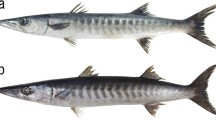Abstract
Two new species of homalorhagid kinorhynchs from the deep-sea Guinea Basin are described. Pycnophyes nubilis sp. nov. is easily recognized by the presence of paradorsal setae on segment 1; middorsal processes on segments 1–10, progressively increasing in length towards the posterior segments; and middorsal process on segment 10 extending over the last trunk segment. Pycnophyes farinellii sp. nov. is distinguished by middorsal elevations on segments 2–9 and laterodorsal and ventromedial setae on segments 2 and 9 only. Moreover, males of the latter species lack ventromedial tubes on segment 2—a very uncommon feature among the genus. The systematic significance of this character is discussed in detail.





Similar content being viewed by others
References
Adrianov, A. V., & Malakhov, V. V. (1999). Cephalorhyncha of the world ocean. Moscow: KMK Scientific Press.
Danovaro, R., Gambia, C., & Della Croce, N. (2002). Meiofauna hotspot in the Atacama Trench, eastern South Pacific Ocean. Deep-Sea Research Part I, 49, 843–857.
Herranz, M., Sánchez, N., Pardos, F., & Higgins, R. P. (2014). New Kinorhyncha from Florida coastal waters. Helgoland Marine Research, 68, 59–87.
Higgins, R. P. (1966). Faunistic studies in the Red Sea (in Winter, 1961–1962). Part II: kinorhynchs from the Area of Al-Ghardaqa. Zoologische Jahrbücher Systematik Oekologie Geographie der Tiere, 93, 118–126.
Higgins, R. P. (1983). The Atlantic barrier reef ecosystem at Carrie Bow Cay, Belize, II: Kinorhyncha. Smithsonian Contributions to the Marine Sciences, 18, 1–131.
Higgins, R. P. (1991). Pycnophyes chukchiensis, a new homalorhagid kinorhynch from the Arctic Sea. Proceedings of the Biological Society of Washington, 104, 184–188.
Kristensen, R. M., & Higgins, R. P. (1991). Kinorhyncha. In F. W. Harrison & E. E. Ruppert (Eds.), Microscopic anatomy of invertebrates (Aschelminthes, Vol. 4, pp. 377–404). New York: Wiley.
Lang, K. (1949). Echinoderida. In N. H. Odhner (Ed.), Further zoological results of the Swedish Antartic Expedition 1901–1903, Vol. IV, No. 2 (pp. 1–22). Stockholm: Norstedt and Sönner.
Lang, K. (1953). Reports of the Lund University Chile Expedition 1948–1949. 9. Echinoderida. Kungliga Fysiografiska Sällskapet i Lund Handlingar, N.F, 64, pp. 1–8.
Martorelli, S., & Higgins, R. P. (2004). Kinorhyncha from the stomach of the shrimp Pleoticus muelleri (Bate, 1888) from Comodoro Rivadavia, Argentina. Zoologischer Anzeiger, 243, 85–98.
Neuhaus, B. (2013). Kinorhyncha (Echinodera). In A. Schmidt-Rhaesa (Ed.), Handbook of zoology, Gastrotricha, Cycloneuralia and Gnathifera (Nematomorpha, Priapulida, Kinorhyncha, Loricifera, Vol. 1, pp. 177–343). Berlin: Walter de Gruyter.
Neuhaus, B., & Blasche, T. (2006). Fissuroderes, a new genus of Kinorhyncha (Cyclorhagida) from the deep sea and continental shelf of New Zealand and from the continental shelf of Costa Rica. Zoologischer Anzeiger, 245, 19–52.
Neuhaus, B., & Sørensen, M. V. (2013). Populations of Campyloderes sp. (Kinorhyncha, Cyclorhagida): one global species with significant morphological variation? Zoologischer Anzeiger, 252, 48–75.
Reinhard, W. (1881). Über Echinoderes und Desmoscolex der Umgegend von Odessa. Zoologischer Anzeiger, 4, 588–592.
Reinhard, W. (1885). Kinorhyncha (Echinoderes), leur structure anatomique et leur place dans le systeme. Travaux dela Societe des naturalistes a l’Universite Imperiale de harkow, 19, 205–305.
Sánchez, N., Pardos, F., Herranz, M., & Benito, J. (2011). Pycnophyes dolichurus sp. nov. and P. aulacodes sp. nov. (Kinorhyncha, Homalorhagida, Pycnophyidae), two new kinorhynchs from Spain with a reevaluation of homalorhagid taxonomic characters. Helgoland Marine Research, 65, 319–334.
Sánchez, N., Herranz, M., Benito, J., & Pardos, F. (2012). Kinorhyncha from the Iberian Peninsula: new data from the first intensive sampling campaigns. Zootaxa, 3402, 24–44.
Sánchez, N., Rho, H. S., Min, W. G., Kim, D., & Sørensen, M. V. (2013). Four new species of Pycnophyes (Kinorhyncha: Homalorhagida) from Korea and the East China Sea. Scientia Marina, 77, 353–380.
Sánchez, N., Pardos, F., & Sørensen, M. V. (2014a). A new kinorhynch genus, Mixtophyes (Kinorhyncha: Homalorhagida), from the Guinea Basin deep-sea, with new data on the family Neocentrophyidae. Helgoland Marine Research, 68, 221–239.
Sánchez, N., Herranz, M., Benito, J., & Pardos, F. (2014b). Pycnophyes almansae sp. nov. and Pycnophyes lageria sp. nov., two new homalorhagid kinorhynchs (Kinorhyncha, Homalorhagida) from the Iberian Peninsula, with special focus on introvert features. Marine Biology Research, 10, 17–36.
Sørensen, M. V. (2013). Phylum Kinorhyncha. Zootaxa, 3703, 63–66.
Sørensen, M. V., & Pardos, F. (2008). Kinorhynch systematics and biology—an introduction to the study of kinorhynchs, inclusive identification keys to the genera. Meiofauna Marina, 16, 21–73.
Sørensen, M. V., Pardos, F., Herranz, M., & Rho, H. S. (2010). New data on the genus Paracentrophyes (Homalorhagida, Kinorhyncha), with the description of a new species from the West Pacific. The Open Zoology Journal, 3, 42–59.
Yamasaki, H., Kajihara, H., & Mawatari, S. F. (2012). First report of kinorhynchs from Hokkaido, Japan, including a new species of Pycnophyes (Pycnophyidae: Homalorhagida). Zootaxa, 3425, 23–41.
Zelinka, C. (1913). Die Echinoderen der Deutschen Südpolar-Expedition 1901–1903. Deutsche Südpolar-Expedition XIV, Zoologie VI, pp. 419–437
Zelinka, C. (1928). Monographie der Echinodera. Leipzig: Verlag Wilhelm Engelmann.
Acknowledgments
The authors want to thank participants of the R/V Meteor Diva2 M63/2 Cruise and the staff and students of the Senckenberg Research Institute in Wilhelmshaven for collecting and sorting the specimens used in this study. Special thanks are given to Dr. Pedro Martínez Arbizu for making the specimens available for us. This research received support from the SYNTHESYS Project http://www.synthesys.info/ to Nuria Sánchez, which is financed by European Community Research Infrastructure Action under the FP7 "Capacities" Program. We also thank Dr. Jon Norenburg, William Moser, and Kathryn Ahlfeld, Smithsonian Institution, for loaning us specimens of Pycnophyes egyptensis from the collections of the USNM as well as for letting us study the kinorhynchs collection of the USNM, adding herein new information of species previously described. This work was supported by the Research Project CGL 2009-08928 (Ministerio de Ciencia y Tecnología, Government of Spain).
Author information
Authors and Affiliations
Corresponding author
Rights and permissions
About this article
Cite this article
Sánchez, N., Pardos, F. & Sørensen, M.V. Deep-sea Kinorhyncha: two new species from the Guinea Basin, with evaluation of an unusual male feature. Org Divers Evol 14, 349–361 (2014). https://doi.org/10.1007/s13127-014-0182-6
Received:
Accepted:
Published:
Issue Date:
DOI: https://doi.org/10.1007/s13127-014-0182-6




